Female Hair Loss – Causes and Treatment Options
Even though hair loss is often considered to be a problem for male patients, it can actually impact the hair of many female patients. There are multiple reasons women can experience hair loss and they range from medical issues to changes in their hormones to sudden stress. Let’s take a look at the issue of female hair loss and the treatment options available to patients.
Signs of Female Hair Loss
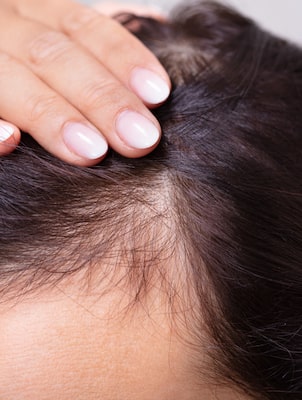 Hair loss can start to become present on the scalp in many different ways. There might be a gradual thinning of the hair, the appearance of a bald spot or sudden hair loss all over the scalp.
Hair loss can start to become present on the scalp in many different ways. There might be a gradual thinning of the hair, the appearance of a bald spot or sudden hair loss all over the scalp.
- Bald spots can start to appear, and they generally have a look that is patchy or circular on the scalp.
- A gradual thinning of the hair on the top of the head is considered to be the most common type of hair loss for both men and women. Male patients tend to show a receding hairline while women start to notice a broader appearance to the part in their hair.
- Patients that suffer some sort of physical or emotional trauma can experience sudden hair loss where the hair quickly comes out of the scalp while combing or washing it. The appearance is normally one of overall thinning on the scalp.
- There are some instances where a full amount of hair loss can happen, and this is especially true with medical treatments such as chemotherapy.
Female-pattern baldness can also be caused by genetics and the aging process. It normally results in miniaturized hair that becomes finer in appearance, than regular hair, over time.
If the hormones are altered or disrupted thanks to medical issues like thyroid problems, the result can be hair loss on the scalp. A reduction in the production of hormones known as estrogen and progesterone can lead to stress on the body that can trigger hair loss.
The doctor examining the patient will take the symptoms the patient is experiencing into account when making a diagnosis about the cause of the hair loss. Besides a physical examination of the scalp, the doctor might decide to perform a medical test such as a scalp biopsy or a blood test.
Female Hair Loss Treatments
The type of treatment for the hair loss suffered by a female patient depends on the cause of the hair loss and the amount of the loss on the scalp.
A hair transplant can help to restore the hairline and give it a more youthful and rejuvenated look. The most popular hair transplant choice is often Follicular Unit Extraction (FUE). During FUE hair restoration surgery, the surgeon removes hair grafts on an individual basis from the donor area on the body. The individual removal of the hair grafts means there will not be a linear scar left on the body that makes it obvious to others that a hair transplant was performed. The hair grafts are then placed in premade incisions in the scalp where they will begin to grow and give the hairline a fuller and denser appearance. The results of a hair transplant are natural in appearance and will last a lifetime.
Minoxidil, which is sold under the brand name of Rogaine, is an over-the-counter medical treatment that is available in both foam and liquid forms. The medication is placed on the scalp on a daily basis so it can stimulate the growth of hair on the scalp. The use of minoxidil is a long-term commitment as the results will only last as long as the product is being used on a regular basis. If the patient stops applying minoxidil on a daily/regular basis, the gains that have been made on the scalp will eventually be lost.
While it is not used as much as in the past, hormone replacement therapy has been shown to be a treatment for androgenic alopecia. The treatment program focuses on supplying the hormone known as estrogen to the patient in order to help offset decreasing levels of the hormone in the body.
Female Hair Loss – The Next Steps
Women that are experiencing hair loss need to realize they are not alone and that it is a natural occurrence with women of all ages.
The first step is contacting a board-certified doctor who is experienced in treating the issue of female hair loss. The surgeon will study the scalp in order to determine the underlying cause of the hair loss. The doctor will also take the time to discuss the issue of hair loss with the patient and answer any questions she has about the medical condition and her available treatment options. It is also important for the doctor to discuss the hair restoration goals of the patient in order to help set realistic expectations when it comes to the final results.
Once the surgeon and the patient are on the same page about the treatment plan, the process can begin to address, and even reverse, the hair loss suffered by the patient.
Male Pattern Baldness – Why it Happens
Male hair loss, which is also known as male pattern baldness, is considered to be the most common type of hair loss in male patients. In fact, the U.S. National Library of Medicine claims that more than 50% of all men (over the age of 50) will find their scalp impacted by male pattern baldness at some point in their lives. What is the cause of male hair loss? What can be done treat the issue? Take a look below to learn the reasons why male pattern baldness (MPB) happens to men.

Male Pattern Baldness – Reasons for the Condition
One of the main causes of male pattern baldness is genetics which means the patient has baldness in their family history. Researchers have found that MPB has an association with androgens (which are male sex hormones). One of the many functions of androgens is regulating the growth of hair. Each individual hair on the scalp has a growth cycle but male pattern baldness causes the growth cycle to weaken. In turn, the hair follicle shrinks to the point that it produces hair that is finer and shorter in appearance and texture. The hair growth cycle, for each hair, will eventually stop and there will be no new hair growing to take its place.
In order to accurately determine the extent of the MPB suffered by the patient, the doctor will examine the pattern of hair loss on the scalp. The medical professional will also conduct a full medical history and medical exam to see if there are any other health reasons for the balding or thinning areas on the scalp beyond male pattern baldness.
When and How Does MPB Occur in Male Patients?
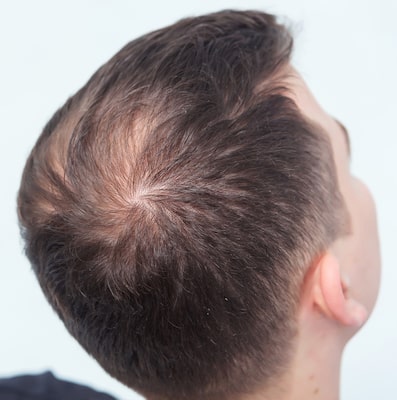
There are some people who begin to experience male pattern baldness as early as their teenage years. However, it most commonly occurs in adult men and the chances of male pattern baldness occurring increase with each passing year. As mentioned above, genetics do play a big role in developing MPB since men with close relatives with the condition are normally considered to be at a higher risk.
Men who are seeing some loss of hair, at either the crown of the head or at their temples, might be experiencing male pattern baldness. The appearance could be seen as a bald spot or as a “M” shape that forms as the hairline continues to recede. Depending on the extent of the condition, the hairline can continue to experience receding until a good portion of the hair is gone (or even all of the hair is impacted by the receding of the hairline).
How to Treat Male Pattern Baldness
Before patients turn to a surgical procedure to treat the balding areas of the scalp, they often ask about medical treatments that can address the issue. The FDA has approved two medications for hair loss that are quite popular with patients:
- Minoxidil, which is also known by the brand name Rogaine, is a topical treatment that can be purchased over the counter as either a foam or liquid spray. Minoxidil is a vasodilator that causes the blood vessels to dilate, under the skin of the treated area, which results in the flow of blood in the body increasing due to blood vessel dilation. The product results in a longer hair growth cycle and a larger amount of hair coverage on the scalp.
- Finasteride, also known by the brand name Propecia, is a prescription oral medication for the treatment of MPB. Finasteride slows down the hair loss of a patient and it also stimulates new hair growth on the scalp. The treatment lowers DHT (dihydrotestosterone) levels in the body. DHT is an androgen in the body that shrinks hair follicles and activates hair loss by making the hair growth cycle shorter than usual. The hair will become thin and brittle and fall out at a faster rate.
Patients that want to have a surgical hair loss treatment can undergo a hair transplant to address the balding and thinning sections on the scalp. Follicular unit extraction (FUE) hair transplant is when a surgeon individually removes hair grafts from the donor area of the scalp (which is often the back and sides of the scalp). The hair grafts that are removed by the surgeon are then transplanted into premade incisions in the scalp. These hair grafts will promote the growth of new hair and provide the patients with a fuller and more youthful looking hairline.
While there are treatments for male pattern baldness, patients will not know their best option until they schedule a consultation appointment with a board-certified surgeon who is experienced in diagnosing and treating hair loss. The doctor will examine the scalp to identify the reason for the loss of hair on the scalp as well as determine the best treatment option for the issue of male pattern baldness suffered by the patient.
– MA
New Cure for Baldness? See the Hair Raising Truth of a Harvard Study
Hair loss impacts both men and women and can have a negative impact on the self-confidence and self-image of a person. Balding and/or thinning hair can be caused by various factors including heredity, a hormonal imbalance, autoimmune conditions, medications, or an infection. Scientists have spent many years researching hair loss and trying to find a cure for baldness. While a simple cure for baldness has not been found yet, there is some indication that one might be here in the near future.
Harvard University and a Possible Cure for Baldness
 It was revealed earlier this year that scientists at Harvard University think they might have discovered a method that can restore hair that has been thinning or balding.
It was revealed earlier this year that scientists at Harvard University think they might have discovered a method that can restore hair that has been thinning or balding.
The scientists conducted experiments on mice that identified the mechanism that results in hair loss in rodents due to stress. The research team believes their findings might be able to be translated into a hair restoration treatment that can treat all hair loss causes.
Ya-Chieh Hsu, of Harvard University, said “We are definitely excited by these findings – I think the technique has great potential.” Hsu did add a note of caution by saying, “Our discovery is only the first key step and more work needs to be done before it can be applied to humans.”
In other words, Hsu is cautioning the public not to consider the findings to be the first step towards any kind of miracle cure when it comes to hair loss. “We do not know the exact scope of its applications. Hair loss can have many complicated causes – there is still a lot to be learned.”
Dr. Hsu also noted that it is too early in the process to tell when any type of human hair loss treatment would be available. It is also too early to tell if the potential human hair loss treatment would be administered through an injection, tablet, or some other method.
Harvard Hair Loss Study – A Closer Look
In the study conducted by the research team at Harvard, the research staff looked at how corticosterone, which is a hormone in mice that is released during periods of chronic stress, works to regulate the activity of hair follicles found in mice.

The experiments conducted by the research team showed when the levels of corticosterone are elevated, the hair follicles will not regenerate and end up staying in an extended resting phase. The experiments also showed the fact that, when the hormone levels are depleted, the stem cells of the hair follicles are activated, and new hair begins to grow.
The research team also found that corticosterone works to inhibit the activation of the stem cells of hair follicles by suppressing the production of a protein known as GAS6. This protein has been shown to promote the rapid increase of the reproduction of hair follicle stem cells where there is an absence of corticosterone.
This medical discovery seems to suggest that the boosting of GAS6 levels can promote hair growth by helping to reduce or overcome the inhibition of hair follicle stem cells due to stress. It is also believed that the boosting of the GAS6 levels might lead to the growth of hair in cases where stress is not the primary factor in the loss of hair.
Dr. Hsu remarked, “Given the potential effect of GAS6 on promoting hair follicle stem cell activity, it would also be interesting to see if GAS6 might be helpful for promoting hair growth in general beyond stress in the future. Our research showed that GAS6 can promote hair growth independent of stress in mice, but we still need to learn more about its impact on human skin.”
While many experts in the field of hair loss and hair restoration agree that the results of the study are promising, they also caution that more work needs to be done before an actual “cure” for baldness can be made available to the public.
The Best Current Solution for Hair Loss
Until an actual cure for thinning or balding hair is available to the public, the best medical option to restore hair on the scalp is a hair transplant.
This medical hair loss solution is performed by moving hair grafts from one area on the body of the patient to the balding or thing area on the scalp. The donor hair is normally taken from the back and sides of the scalp as the hair in this area is resistant to hair loss.
The results of a hair transplant give the patient a fuller and more youthful head of hair that is also natural in appearance. The results last a lifetime and improve the confidence and self-image of a person.
Interested in learning more about how a hair transplant can transform the look of your hairline? Contact our office today to schedule a consultation appointment about your hair restoration options.
– MA
Finasteride and Depression – The Facts Revealed
For many people, the idea of losing their hair is not a pleasant one. Once they start to actually start to suffer from hair loss, they often turn to medications and treatments to try and slow down, or reverse, the growing amount of balding or thinning hair on the scalp. One of the most popular prescription medications to treat male pattern hair loss is finasteride which blocks the production by the body of a male hormone, in the scalp, that can stop the growth of hair. Even though finasteride is a very popular hair loss treatment, there have been recent reports about a connection between finasteride and depression among those that use the product.
Finasteride and Depression – See the Connection
Finasteride, which is sold under the brand name Propecia, was the recent subject of an investigation by Reuters. The news agency reported on unsealed court documents and records that showed both Merck (a drug manufacturer) and United States regulators were aware of reports that revealed suicidal behavior among patients using the drug. In addition, it was revealed that they failed to include information about these possible risks in a 2011 updated of the warning label of the drug.

Reuters also revealed that, since this information was made know to the public, the U.S. Food and Drug Administration (FDA) has received more than 700 reports of deaths by suicide, or suicidal thoughts, among people who either use Propecia or one of its generic versions. This number included at least 100 patient deaths. It was also reported that, withing the first 14 years of the sales of Propecia, the FDA received 34 of these reports (which included 10 patient deaths).
In addition, Reuters reports that an internal assessment by Merck revealed 200 reports of depression and/or suicidal ideation among make users. It was determined that the total number of these reports were not high enough to require more than regular data monitoring. (This included the number of cases of depression and suicidal behavior not being high enough to need more than regular date monitoring).
It was also reported, in a study published last year, that reports of anxiety, suicidal thoughts and depression, among patients age 45 or younger, who used the drug in a significant manner since 2012. The information was obtained from a World Health Organization (WHO) database of drug safety reports from more than 150 nations.
Finasteride and Depression – Merck Speaks Out on the Subject
When asked by Reuters about these reports, Merck said “the scientific evidence does not support a casual link between Propecia, and suicide or suicidal ideation and these terms should not be including in the labeling. Merck works continuously with regulators to ensure that potential safety signals are carefully analyzed and, if appropriate, included in the label for Propecia.”
The U.S. Food and Drug Administration also issued a statement saying it “continues to monitor postmarketing safety data for Propecia.” The FDA added that the information in these reports do not necessarily indicate that the drug caused “the adverse event”. Instead, any type of related medical issue can be the result of the “underlying disease being treated, caused by some other drug being taken concurrently, or occurred for other reasons.”
Patients and Finasteride – Should They be Concerned?
While Propecia is an effective hair loss treatment, patients should exercise caution and also be aware of their mood while they are taking the medication. It is also recommended for them to seek out alternative treatment methods if they have a history of issues such as depression or mental health problems.
Any patients with a history of issues such as depression should schedule a consultation with a doctor in order to discuss the use of the medication and to determine if it is an appropriate medical treatment that will lead to mental health issues as it is being used.
The issue of hair loss impacts everyone differently and goes beyond the visible signs of hair thinning or balding. The loss of hair on the scalp can have a negative impact on the self-image of a person and cause them to suffer doubt or a lack of confidence about their look.
Where there is less public shame or stigma attached to balding than there was in the past, the loss of hair on the scalp can be quite traumatic and have a negative on how people feel about their appearance.
Any questions or concerns about the use of finasteride should be discussed in advance with a board-certified medical professional who is experienced in treating hair loss. The doctor will examine the scalp of the patient in order to identify the cause of the hair loss and to determine if finasteride is the best option to address the issue. The doctor will also conduct a complete examination of the person to make sure the patient is, mentally and physically, an ideal candidate for a hair loss treatment plan.
– MA
Scalp Micropigmentation – How SMP Treats Hair Loss ASAP
According to the American Hair Loss Association, two-thirds of men start to notice thinning hair by the time they turn 35. As they grow older, around 85% of men will start to show a significant amount of hair loss by the age of 50. No matter the level of their hair loss, there are multiple options available for men suffering from a balding scalp. It is important to remember there is not one specific solution that will handle the hair loss needs of all patients. One hair restoration option that some patients might not know much about is scalp micropigmentation (SMP).
Scalp Micropigmentation Explained
The process of having scalp micropigmentation is similar to having a tattoo placed on the body. The process creates the appearance of hair on the scalp using a microneedle and pigments. SMP can cover and/or camouflage thinning areas on the scalp, as well as bald spots on the scalp, by creating the appearance of a hairline that has the look of a closely shaved head.
During the procedure, our team will infuse a series of pigments into the scalp in order to produce the appearance of short hair. Microneedles are used to place the pigment at the surface of the scalp. Careful attention is paid to the skin color and the density of the natural hair growth in order to provide a consistent, natural look across the scalp. The final appearance can resemble the appearance of a closely shaved head or SMP can create the appearance of greater fullness by blending in with the current natural appearance of the hair.
Patients should be aware of the fact that it can take multiple treatments (performed every few weeks) to achieve the desired look. The number of treatments needed depends on the total area of the scalp that is receiving the scalp micropigmentation treatment. Each treatment provides a darker and fuller look to the scalp.
Scalp Micropigmentation – Ideal Candidates
Ideal candidates for scalp micropigmentation include:
- Men who shaved their head, due to their patterned baldness, and want to create the look a head that is not balding
- Male and female patients who had a previous hair transplant and want to create the appearance of a fuller head of hair in sections of the scalp that are still visible
- Patients that have a large enough area of balding that they are unable to have a hair transplant to achieve a full head of hair
- A person that wants to cover the appearance of a scalp scar that was the result of trauma to the scalp or an earlier strip hair transplant
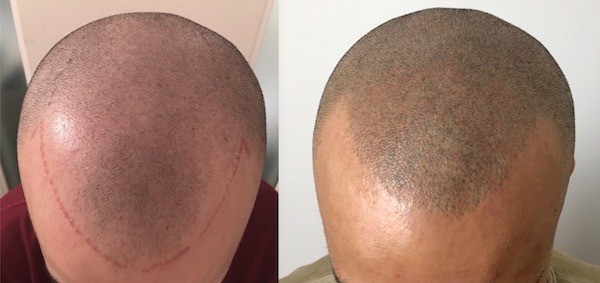
Scalp Micropigmentation – How Long does it Last
The results of scalp micropigmentation vary per person but the pigment will fade over time so patients will need to have a follow-up treatment at some point in the future. The results also depend on the amount of pigment placed in the scalp and if a patient correctly follows the post-op instructions provided by the doctor.
The results of scalp micropigmentation are considered to be semipermanent. While the final results can last for many years, the pigments on the treated area of the scalp will start to fade over time as the skin naturally exfoliates itself. The pigments will simply start to fade instead of turning other colors as it ages.
The fading of the pigments can also happen more quickly to patients that have very dry skin. The skin has a tendency to flake if a person has dry skin and this can also cause the pigment placed in the scalp to exfoliate at a quicker rate.
Scalp Micropigmentation – What are the Risks
Like any other procedure performed on the scalp, there are some risks involved with the performing of scalp micropigmentation. Some of the common risks involved with having a SMP treatment include:
- Itchy scalp
- Allergic to the pigment
- Redness on the scalp
- Rapid fading of the pigment
- Infection
- Scabbing
- Some pigment dots being larger than others (if too much pigment is injected in a particular area)
Scalp Micropigmentation – Benefits Beyond the Scalp
Scalp micropigmentation does more than simply provide the appearance of a closely shaved head for patients. The results of the procedure also give patients a better self-image and greater self-confidence when it comes to their appearance.
Scalp Micropigmentation – Call Today for More Information
Patients that are interested in learning more about scalp micropigmentation are invited to contact our office for more information about the treatment. SMP provides the appearance of a fuller head of hair for patients who do not want to have a hair transplant or those who are not ideal candidates for a hair transplant procedure.
During the consultation appointment, our experienced medical team will answer any questions about scalp micropigmentation as well as share “before and after” photos of our actual patients to show the results that can be expected from the treatment.
Contact us today to learn more about scalp micropigmentation.
Hair Loss Treatments – Discover Your Options
Hair loss, to a certain extent, is a natural occurrence for every person. It is quite common to naturally lose up to 100 hairs per day but, if your hair loss is more than that amount each day, you might be experiencing some form of hair loss. There are several causes for hair loss and the most common one is androgenic alopecia which is also known as male-pattern baldness. Take a look below to learn more about common causes for hair loss as well as a look at some of the most popular and successful hair loss treatments currently available for patients of all ages.
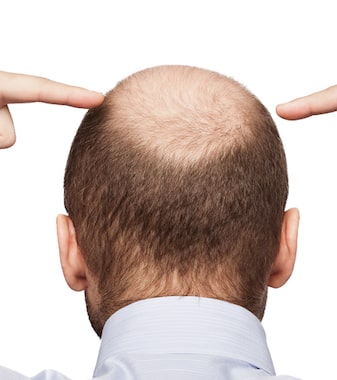
Hair Loss Causes
Besides male-pattern baldness, there are other common causes for hair loss and they include:
- Telogen Effluvium – Sudden stress can lead to hair loss as well as an amount of thinning on the scalp.
- Alopecia Areata – This is an autoimmune disease that can result in the appearance of patchy baldness on the scalp (the patches are usually round in shape and the size of a coin).
- Trichotillomania – The loss of hair on the scalp which is the result of a psychological condition that causes people to involuntarily pull their hair in certain areas of the scalp.
- Traction Alopecia – Hair loss that is the result of the continuous pulling of hair in a certain area of the scalp (thanks to hairstyles such as long braids or ponytails).
Hair Loss Treatment
The type of hair loss treatment for a patient depends on the amount of hair loss, the reason for the hair loss and the results the patient wants to experience. Popular hair loss treatment options include:
- Finasteride (Propecia) – This is a prescription oral medication that is available for purchase under the brand name, Propecia. Finasteride is FDA-approved for the treatment of male pattern baldness as it slows down the amount of hair loss and also stimulates the growth of new hair on the scalp. The medication works by lowering the levels of DHT in the body. Dihydrotestosterone (DHT) is an androgen that can cause hair loss by shrinking the hair follicles of a person and also causing the hair growth cycle to be shorter than normal. This results in the hair falling out faster because it is thinner and more brittle. It can take around four months to start seeing any results from finasteride. Patients should be aware of the fact that finasteride is not a permanent hair loss solution and the results that have been gained will go away if you stop taking it on a regular basis.
- Minoxidil (Rogaine) – Unlike finasteride, minoxidil is a topical treatment option that is sold over the counter so you do not need a prescription to obtain the product. Minoxidil is available as a foam or as a liquid spray and is sold under the popular brand name, Rogaine. Minoxidil is a vasodilator which means it dilates the blood vessels under the skin in order to increase the flow of blood. While the exact mechanism of action for minoxidil, AKA the active ingredient, is not completely clear, there is a belief that it works by partially enlarging the hair follicles and elongating the growth phase of the hair on the scalp. If there are more follicles in the growth phase of the hair cycle, you will then see more hair coverage on your scalp. You need to be aware that your hair will start to shed early on when you start to use minoxidil. Do not worry as this is perfectly normal and it simply means the hair on the scalp is transitioning from the resting phase to the growth stage of the hair growth process. Just like finasteride, minoxidil will only work for as long as the product is used on a regular basis. If you stop using it on a regular or consistent basis, the hair loss on the scalp will resume.
- Hair Transplant – The most effective, natural and long-lasting method to treat hair loss is undergoing a hair transplant. The donor hair for hair transplant surgery is usually taken from the donor section of the scalp (the back and sides of the scalp) and moved to the balding/thinning areas of the scalp. The most popular hair transplant method is Follicular Unit Extraction (FUE) where the hair is removed from the donor area on an individual basis so there is no chance of a linear scar happening (as in older hair transplant methods). The hair that is transplanted is resistant to balding which means you do not have to worry about losing it once it is transplanted to the scalp. The other areas of the scalp, not treated by the hair transplant, can still lose hair so there is a possibility that you might want to have an additional procedure in the future.
Hair Loss Consultation Appointment
The first step in the hair loss treatment process is scheduling a consultation appointment with a board-certified doctor who is experienced in treating hair loss. The doctor will examine your scalp to determine the amount of hair loss as well as the reason for the condition.
Once the medical reason for the hair loss has been identified, the doctor can discuss your options to determine the next step in providing you with the hairline you desire.
If you are suffering from hair loss and would like to address the issue, we invite you to contact our office to schedule a Los Angeles hair transplant consultation appointment or a San Francisco hair transplant or a Beverly Hills hair restoration consultation appointment.
“Hair Plugs” Hair Transplant Surgery – Is it Still Performed?
One of the misconceptions about a hair transplant is that some members of the general public think they are still performed using what is commonly referred to as “hair plugs”. This term refers to the type of hair transplants that were performed starting in the 1950s and lasting until the late 1990s/early 2000s. During this type of hair transplant procedure, the surgeon would “punch out” large sections of hair and skin from the donor area on the back of the scalp in order to transplant the hair grafts into the balding sections of the scalp.
Is hair plug surgery still performed? Let’s take a look at the history of this technique along with the evolution of hair transplant surgery to get the answer.
Hair Plugs History – How it Started
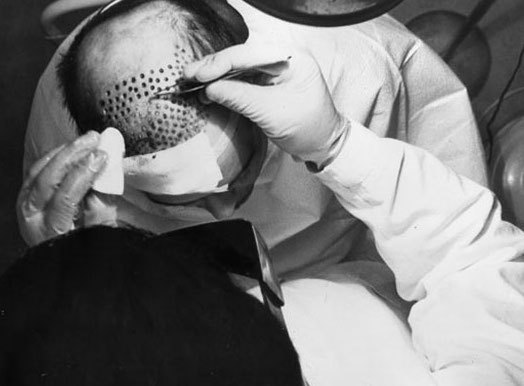 The use of hair plugs was first performed by Dr. Norman Orentreich in the 1950s. The plugs (also known as round sections of hair follicles and skin) were removed from the back of the head and were generally about four millimeters across.
The use of hair plugs was first performed by Dr. Norman Orentreich in the 1950s. The plugs (also known as round sections of hair follicles and skin) were removed from the back of the head and were generally about four millimeters across.
While the hair plugs were inserted into the balding areas of the scalp, the final results were not as natural in appearance as modern hair transplant techniques. The appearance of the hair plugs was often referred to as “doll hair” or “doll-like” in nature. As time passed, surgeons were able to use hair grafts that were smaller in size and the results became more natural in appearance.
Hair Plugs – Is This Hair Transplant Technique Still Performed
Hair plugs finally fell out of style and were considered to be outdated by the start of the 21st century. They were eventually replaced by the use of Follicular Unit Transplantation (FUT) and Follicular Unit Extraction (FUE). These techniques are more advanced and are able to be performed quicker than hair plugs while providing natural results that last a lifetime.
Patients prefer to have FUE as the hair grafts are removed on an individual basis from the donor area of the scalp (usually the back and sides of the scalp). The hair from the donor area is resistant to balding and will grow like natural hair once it is transplanted into the balding section of the scalp.
Unlike hair plugs, there is little risk of scarring after the procedure. Plus, the act of individually transplanting hair follicles from the donor area of the scalp means the surgeon is able to achieve a more natural look than is possible with hair plugs that are larger in size.
Hair Plugs Risks and Side Effects
While hair plugs were a revolutionary method of restoring the hair on the scalp, there were many risk and side effects during the procedure. Some of the most common risks patients needed to worry about included:
- Scarring on the scalp after the procedure
- Results that looked like the hair on a doll
- Swelling
- Pain
- Numbness in the area where the hair plugs were removed and/or where they were implanted in the scalp
- Bleeding
- Infection
- Ingrown hairs
Hair Plugs and a Hair Transplant – Can Patients Switch from One to Another
Patients that received hair plugs in the past might not be sure if they can update and/or revise their results using a modern hair transplant method like FUE.
It is possible for previous hair plugs patients to undergo a modern hair transplant if they have enough available donor hair on the scalp or elsewhere on the body (such as the beard or the chest). The amount of available donor hair on the body of a patient can be determined during a consultation appointment with a board-certified doctor that is experienced in performing hair transplants.
It is not an option to have an additional hair plugs procedure as this is considered to be an obsolete hair transplant method. Even though some people still use the term “hair plugs” to refer to hair transplants using modern techniques, this hair restoration method is not performed in the present day.
Hair Transplant – How to Start the Process
The first step in having a hair transplant is performing proper research to learn more about the procedure including what is involved in having the surgery. A potential patient also needs to research doctors in their area, or across the country, to learn more about the results they have provided actual patients in the past.
Once the decision is made about which doctor to visit, a consultation appointment should be scheduled in order to have a one-on-one meeting with the surgeon. The doctor will examine the scalp of the patient to assess the available amount of donor hair along with performing a general physical examination of the patient to make sure the person is healthy enough to have a surgical procedure.
The consultation appointment is also the time for the patient to ask any questions they have about the hair transplant process and for the doctor to set realistic expectations about the final results.
Anyone interested in enjoying the results provided by modern hair transplant techniques is invited to contact out team today to schedule a consultation appointment at any of our California offices:
Obesity and Hair Loss – Are They Related?
When it comes to hair loss, the first thing that often pops into the mind of the public is the loss of hair being caused by genetics or less likely as the result of a medical condition or infections. There is nothing wrong with this line of thinking as hair loss can be caused by these conditions. However, a recent report is spotlighting the idea that obesity might play a part in the hair loss of an individual. The study was conducted by some of the researchers at the Department of Stem Cell Biology at Tokyo Medical and Dental University.

Obesity and Hair Loss – Is There a Connection?
According to Webster’s Dictionary, obesity is “a condition that is characterized by the excessive accumulation and storage of fat in the body”. A person that has excessive body fat runs the risk of suffering from health problems as the condition often results from the intake of a larger amount of calories than are burned off through the normal daily activities and exercise habits of the person.
In general, obesity can predispose people to diseases associated with age. The exact effect that obesity has on organ dysfunction is not well-known at the moment.
Hair follicles on the scalp (that grow hair) are miniaturized by the aging process. In turn, this can cause hair loss to occur on the scalp through the depletion of hair follicle stems cells.
Obesity and Hair Loss – Results from a Recent Study
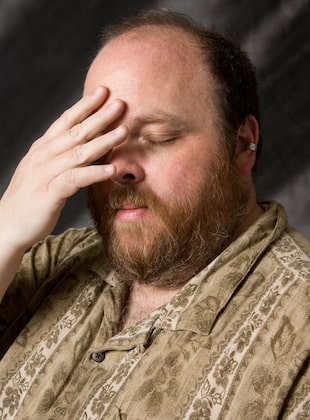 In a recent report about this study, found on nature.com, it was revealed that stress can be induced by obesity. The stress that is induced on the body by a high fat diet can target hair follicle stem cells and accelerate the hair thinning process.
In a recent report about this study, found on nature.com, it was revealed that stress can be induced by obesity. The stress that is induced on the body by a high fat diet can target hair follicle stem cells and accelerate the hair thinning process.
In addition, an analysis of chronological gene expression showed that following a diet that is high in fat (for four consecutive days) in young mice directed the activated hair follicle stem cells in the mice towards epidermal keratinization. Keratinization is the process where the cytoplasm of the outermost cell of the epidermis is replaced by keratin (the protein type that makes up the skin, hair, and nails). The epidermal keratinization process happened in species that generate excessive reactive oxygen, but the process did not reduce the available amount of hair follicle stem cells.
The use of integrative analysis for stem cell fate tracing, epigenetics and reverse genetics showed that the continued practice of a high fat diet led to the inducing of lipid droplets and NF-kB activation within the hair follicle stem cells (though paracrine and/or autocrine IL-1R signaling).
These integrated factors were found to converge on the marked inhibition of Sonic hedgehog signal transduction in hair follicle stem cells. The result was a further depletion of hair follicle stem cells, that are lipid-laden, through their total amount of aberrant differentiation and the induction of hair follicle miniaturization (as well as eventual hair loss).
Obesity and Hair Loss – What does the Data Tell Us?
Now that the data from the study is listed above, what does it mean when it comes to obesity having an influence on the hair loss process?
Taken together, the data shows that stem cell inflammatory signals, that are induced in a patient by the condition known as obesity, greatly represses organ regeneration signals which also leads to a greater acceleration in the miniaturization process of mini organs. In addition, it also seems to suggest that the daily prevention of any type of organ dysfunction plays a big part in the continued health of a patient and often helps to slow down, delay or prevent hair loss from occurring in a patient.
Hair Loss – What Can You Do about it?
The issue of hair loss has long been an area of concern for patients of all ages. The loss of hair on the scalp can have a negative impact on the confidence and self-esteem of a person while also leading the person to try and hide the appearance of thinning hair with a hat or simply not going out in public to meet others.
There are multiple symptoms of hair loss that can appear on the scalp and they include:
- Patterned hair loss that is quite gradual and starts on the top, front, and crown areas of the scalp.
- Sudden hair loss can be the result of an emotional or physical shock experienced by a person. The hair can start to become loose on the scalp and this is generally known as “shock loss”.
- Patchy bald sports, and/or circular bald spots, can occur on the scalp. This patchy hair loss can sometimes be caused by an autoimmune disease or it can be self-inflicted due to continuous hair pulling (trichotillomania).
If you are suffering from hair loss of any degree on the scalp, you can schedule a consultation appointment with our team to learn more about the reasons for the condition. Our experienced team will examine your scalp to determine the cause of your hair loss and create an individualized medical plan to restore a youthful and healthy hairline on your head.
If you want to know more about the benefits of a Los Angeles hair transplant, or a San Francisco hair transplant for our friends in Northern California, contact us today and take the first steps towards making your hair loss a thing of the past.